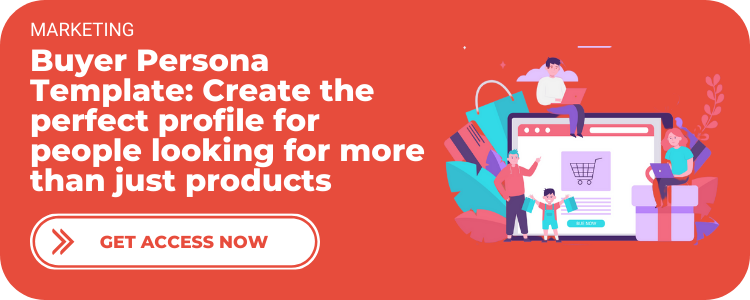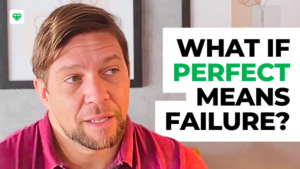If you’re following our Buyer Persona video series, you know all you need to create the most profitable Buyer Persona Templates for your brand.
So, the last step of our conversation is to learn what a Buyer Persona Template actually looks like.
We’re covering from basic demographics to advanced psychological profiling in 5 stages.
We will also use some case studies to show you how profitable buyer persona templates should look like.
But before we get into it…
Let’s dive in.
Buyer Persona Template Part #1: Demographics
Demographics is all about how to categorize Personas based on their personal information. Think of it as a basic stage to help you tailor your message.
Name
The 2 most powerful words in any language and across every culture are:
- You: which is a direct address to someone.
- Name: a direct and intimate address to someone.
Address your audience by their names when possible. If it's not, use the second person – you.
Avoid speaking to mass audiences because you end up speaking to no one.
But here’s the catch, to address buyer personas by name, you must get that information as soon as possible during the Buyer’s Journey.
The most effective way of doing so is by converting prospects into email subscribers.
Age
Did you know that every word is associated with an age range? Check these words:
- Mom.
- Mother.
- Motherhood.
Words differ by complexity and by the age of people interested in that subject.
Why does that matter? The core idea is: the lower the age association, the easier it is to understand your message.
If you try to apply ages to those 3 words I mentioned, you will find that:
- The first one, mom, is for the youngest audience.
- The third one, motherhood, is for the oldest audience.
- And the second, mother, is somewhere in the middle.
Writers, screenwriters, and copywriters adjust the words to deliver a clear message. They use word grading metrics to establish goals for their messaging.
For example, The Flesch Reading-Ease is a readability score to test how easy a piece of content is by associating a score to a grade.
I’m leaving a link to a free online readability score tester and editor in the description. Don’t miss it. It’s gonna do wonders for your copywriting.
Marital status
This data can help you in various ways, depending on the products and services you provide:
Say you are in the wedding industry. You would like to address engaged single couples, not married ones.
On the other hand, if you are in the Relationship Counseling industry. You would like to address married couples.
What if you are in the Baby Clothing industry? You would like to address married couples in a certain age range.
You see, we start to combine those demographics to create a more specific buyer persona, and the more specific they are, the more powerful your message becomes.
Profession
Profession shows which areas of interest your Personas have.
- IT professionals are great Buyer Personas for computer companies.
- Lawyers are great Buyer Personas for tailored suit brands.
- Athletes are great Buyer Personas for running shoes companies.
One recent example is that the COVID pandemic forced the hand around the home office appliances industry.
Gender
You can use this data to understand how different men and women interact with your brand. That helps even if your products are not gender-specific.
Gender can influence your brand colors, brand images, and even, brand typography.
Also, men and women play different buying decision roles. Understanding the nuances between both is crucial.
Buyer Persona Template Part #2: Interests
Fortune cookies are well known for carrying hidden messages.
Lou Montulli coined the term cookie to name data transported from a browser to a web server.
Cookies record our:
- Preferences and interests.
- Employment status.
- Geolocation.
Just to name a few of them.
Cookies allow brands to create targeted ads like it was never possible before.
Using a tool like Google Ads, you can even target buyer personas that are “in-market”, which means that, by their online surfing patterns, we can determine they are looking for a purchase.
How crazy is that?
Buyer Persona Template Part #3: External Problems
External problems are tangible obstacles between people’s current state and their goals.
It manifests itself in the physical world and can be listed as pain points.
Addressing External Problems
In an External Problem scenario:
- Restaurants sell food.
- Plumbers fix pipes.
- Clothing stores sell shirts.
But the reason why people will get interested in doing business with you is not limited to solving external problems.
What I’m saying is that the purchase decision to eat at a certain restaurant is not only led by hunger.
Something else is going on.
And that “something” plays a more powerful impact role in the final decision than just hunger.
Let’s find out what’s really going on.
Buyer Persona Template Part #4: Internal Problems
The anticipation and feeling around what could happen if those external problems occur leads us to Internal Problems.
Addressing Internal Problems
The purpose of external problems is to uncover internal ones. It is about helping your Buyer Personas answer the question: Do I have what it takes?
Your Buyer Persona might feel frustrated, Incomplete, or confused. But that is only a current situation.
Addressing those internal motivators that are being manifested externally, inspires the transformation they are looking for.
In an Internal Problem scenario:
- Restaurants sell health, social status, and identity.
- Plumbers sell family security, tranquility, and financial stability.
- Clothing stores sell an identity, comfort, and social status.
What internal problems do your products solve? A restaurant that sells food will never lead the market. The appeal is too superficial to buyer personas needs.
Buyer Persona Template Part #5: Philosophical Problems
Philosophical Problems are about something larger than even the feelings about the problems. It is about the question “why”.
Why does it matter?
Philosophical Problems can be identified by the words “should” and “shouldn’t”. It is part of how they view themselves in the world.
Addressing Philosophical Problems
Your Buyer Personas need to get involved in stories greater than themselves.
They value brands that give them a voice in a larger narrative and provide a stronger sense of meaning.
In a Philosophical Problems scenario, people ask:
- Why should restaurants care about healthy food?
- Why should plumbers urge to be efficient and reliable?
- Why should clothing stores be inclusive?
Is there a larger cause your brand contributes to?
Are your products tools to fight back against what should not be or give birth to what must be?
Clothing stores using top models to showcase their products are not inclusive and will lose ground to other brands that understand the deep psychological questions of their buyer personas.
Did you get that?
Buyer Persona Templates to use as reference
All right. At this point you should know why your brand needs Buyer Personas, how to create one, and which information is relevant.
Now, Let me show you some examples of real buyer personas so you can see these concepts in action.
Make sure you understand the concepts we covered to translate these examples to your reality.
Shaw we?
BUYER PERSONA TEMPLATE #1: BUSY BOB
- Name: Busy Bob
- Age: 26
- Marital Status: Single
- Profession: Store Manager
- Gender: Male
- Location: New York City.
- Education: BA in Administration
- Interests: Online shopping, sports, travel
- External Problem: Difficulty finding shoes that fit his feet.
- Internal Problem: Lack of identity because he buys shoes that fit, instead of the ones he likes.
- Philosophical Problem: Why should he struggle between comfort and style?
BUYER PERSONA TEMPLATE #2: BRANDY DAY
- Name: Brandy Day
- Age: 37
- Marital Status: Married
- Profession: Psychotherapist
- Gender: Female
- Location: Los Angeles, CA.
- Education: BS in Psychology
- Interests: Lifestyle, healthy food, fashion
- External Problem: Not being able to travel.
- Internal Problem: Stress between geographical flexibility and financial stability.
- Philosophical Problem: Why should she keep herself from traveling more? Why should she focus more on her professional career than freedom? Why does the sense of going anywhere she wants matter?
BUYER PERSONA TEMPLATE #3: SAM SUMMERS
- Name: Sam Summers
- Age: 20
- Marital Status: Single
- Profession: Student
- Gender: Male
- Location: San Francisco, CA
- Education: Full-time interior design student.
- Interests: Home decor, design, and painting.
- External Problem: Not having enough money.
- Internal Problem: Being unable to help his family.
- Philosophical Problem: Why should he be a better student? Why should he get a degree? Why should he be able to make more money?
Feel free to get back to the concepts and compare the practical examples to apply to your business seamlessly.
Conclusion
Buyer persona templates are not just about age, gender, and geo-location.
It’s a full psychological profile that provides transformation and meaning to your audience, and sustainability to your business.
I hope this knowledge serves you well and provides powerful insights to your journey.




